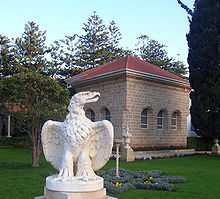Shrine of Bahá'u'lláh


The Shrine of Bahá'u'lláh, located in Bahjí near Acre, Israel, is the most holy place for Bahá'ís and represents their Qiblih, or direction of prayer. It contains the remains of Bahá'u'lláh and is near the spot where he died in the Mansion of Bahjí.
The Shrine of Bahá'u'lláh is composed of a central area that contains a small, tree-filled garden surrounded by paths covered with Persian rugs.[1][2] A glass roof was constructed by Qulám-‘Alíy-i-Najjár after the death of Bahá'u'lláh.[3] At the northwest corner of the central area there is a small room containing Bahá'u'lláh's remains.[4][5] The central area has doors to a number of other rooms that have, in recent years, been opened to accommodate the growing number of pilgrims and visitors.
The shrine, after `Abdu'l-Bahá's death, was occupied by Mírzá Muhammad `Alí and his supporters, who forcibly took the keys to the shrine in January 1922.[6] The governor of Acre ordered the keys to be returned to the authorities and a guard was posted at the shrine.[6] In early 1923 the keys were returned to Shoghi Effendi.[6] In the 1950s, Shoghi Effendi had made plans for a future superstructure, which would surround the whole area and would include a platform with 95 marble columns of 6 meters high.[7] Shoghi Effendi has called the shrine the Daryá-yi-Núr (Ocean of Light), which has taken the Kúh-i-Núr (Mountain of Light, the Shrine of the Báb) under its shadow.[8]
The shrine and its surrounding gardens, as well as the Mansion of Bahjí, was inscribed on the World Heritage List in July 2008.[9][10]
See also
Notes
- ↑ National Spiritual Assembly of the United States (January 1966). "Shrine of Bahá'u'lláh". Bahá'í News (418): 4. Retrieved 2006-08-12.
- ↑ Viswanathan, G. M. (1994-07-24). "Bahá'í Aesthetics of the Sacred". bahai-library.com. Retrieved 2006-08-12.
- ↑ `Abdu'l-Bahá (1915). Memorials of the Faithful. Wilmette, Illinois, USA: Bahá'í Publishing Trust (published 1997). p. 144. ISBN 0-87743-242-2.
- ↑ Manvell, Christ (November 1996). "Visits to the Shrine of Bahá'u'lláh and Meeting with the members of the Universal House of Justice". bahai-library.com. Retrieved 2006-08-12.
- ↑ For pictures of the central room and the inner shrine, see The Bahá'í World, Vol III, p. 5 and 11.
- ↑ 6.0 6.1 6.2 Wilson, Helen T. (April 2000). "The Dispensation of Baha'u'llah: Its Continuing Place In History". bahai-library.com. Retrieved 2006-08-12.
- ↑ Giachery, Ugo (1973). Shoghi Effendi — Recollections. Oxford, UK: George Ronald. pp. 132–134, 137. ISBN 0-85398-050-0.
- ↑ Khadem, Dhikru'llah (March 1976). "Bahá'u'lláh and His Most Holy Shrine". Bahá'í News (540): 15.
- ↑ UNESCO World Heritage Centre (2008-07-08). "Three new sites inscribed on UNESCO’s World Heritage List". Retrieved 2008-07-08.
- ↑ World Heritage Committee (2007-07-02). "Convention concerning the protection of the world cultural and natural heritage". p. 34. Retrieved 2008-07-08.
References
- Smith, Peter (1999). A Concise Encyclopedia of the Bahá'í Faith. Oxford, UK: Oneworld Publications. ISBN 1-85168-184-1.
External links
| Wikimedia Commons has media related to Shrine of Bahá'u'lláh. |
- The Bahá'í Gardens - official Website
- Bahá'í Pilgrimage - Shrine of Bahá'u'lláh
- The Bahá'í Gardens in Bahjí - photo gallery
| ||||||||||||||||||||||||
Coordinates: 32°56′36″N 35°05′32″E / 32.94333°N 35.09222°E
